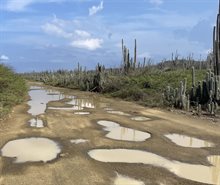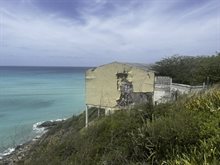What are the consequences?
The climate is changing rapidly: worldwide temperatures are increasing, and the weather is becoming more and more extreme. These changes are occurring at such a rapid pace that the Earth’s ecosystems cannot sufficiently adapt. Climate change impacts both humanity and nature.

Consequences for residents and nature
The following pages provide more information on the consequences for islanders, e.g., in terms of public health, roads, buildings, and tourism. They also outline the consequences for nature, such as the disappearance of seagrass and coral.
Island-level consequences
Consequences for Bonaire
The Climate Impact Atlas for the islands of Bonaire, Sint Eustatius and Saba (Climate Impact Atlas BES) contains a great deal of information on the consequences of climate change for these islands. The Atlas shows what the current consequences are and what consequences are expected for the future.
During a workshop held on 20 October 2023, a session was organised for the island of Bonaire, attended by delegates from the government, nature organisations, the socio-cultural domain and economic sectors. Together, they explored the main consequences of climate change for Bonaire. This workshop was organised by TERRAMAR, Island(er)s at the Helm, Climate Adaptation Services (CAS), the Royal Netherlands Meteorological Institute (KNMI) and Wageningen University & Research (WUR). Interested in the results? The report Climate Impacts for Bonaire (pdf, 3.3 MB) is available for download.
Consequences for Curaçao
KlimaKòrsou, the Curaçao Climate Impact Atlas, presents all the currently available information on the consequences of climate change for the island, with interactive maps, visualisations and explanations. It also contains an interactive mind map on the consequences, which is based on the results of a stakeholders’ workshop held on Curaçao in 2023. Delegates from the government, nature organisations, the socio-cultural domain and economic sectors collectively explored the main consequences of climate change for the island. The results have been published in the report entitled Klimaateffecten op Curaçao [Climate Impacts for Curaçao].

Consequences for Sint Maarten
The island of Sint Maarten has two freshwater bodies: Little Bay Pond and Fresh Pond. This water is vitally important for various bird species, the fish population, molluscs and small invertebrates. These two ponds are already affected by pollution, and changes in precipitation patterns, heavier storms and higher temperatures would jeopardise their survival. On the St. Martin Climate Impact Atlas, you will find clear information about the possible climate effects for Sint Maarten.
Consequences for Aruba
Since May 2025, the Climate Impact Atlas Aruba has been online. There you can find all the information currently available about how climate change affects the island. It includes interactive maps, visualizations, map explanations, statistics, and stories by Aruban writer Rosabelle Illes. The atlas also features an interactive mind map about climate impacts, based on the report Climate Impacts on Aruba. The Climate Impact Atlas Aruba is available in Dutch, English, and Papiamento. In addition, several infographics have been compiled for Aruba, providing information on topics such as climate change, the environment, marine life and air quality. They are available in Dutch, English and Papiamento. Go to the infographics.